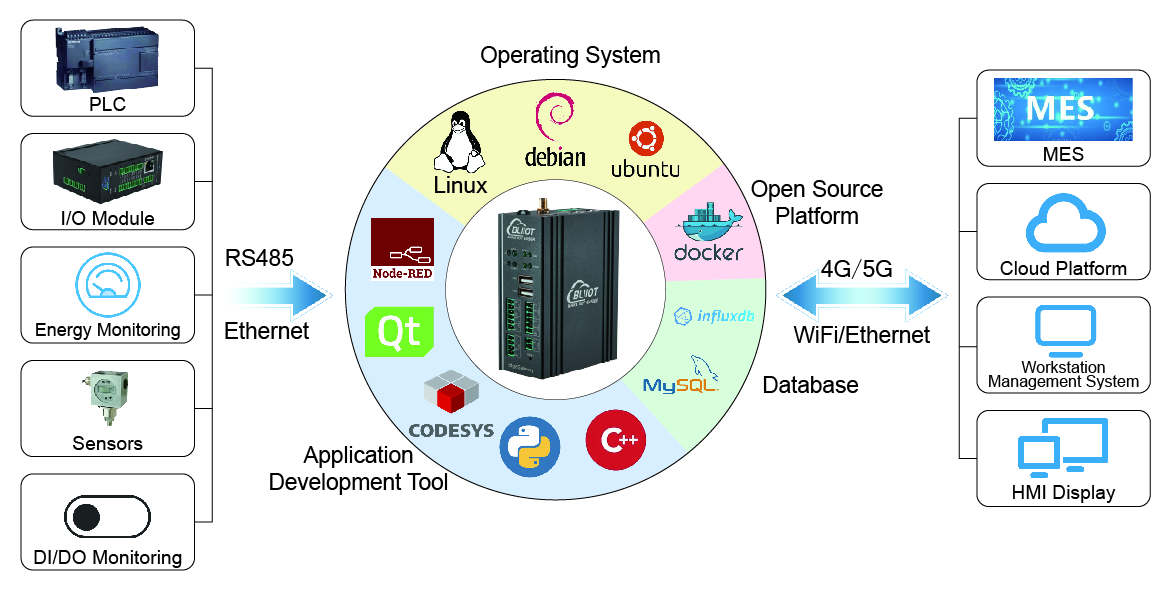IoT Applications
Why EdgeCOM is Important for Building Smart Factories
Views : 6007
Author : Fiona Dai
Update time : 2023-10-24 19:09:37
Why Industrial Edge Computing is Important for Building Maximally Efficient Factories?
Industrial Edge computing ensures that data can be captured, managed, analyzed, and immediate decisions can be made in real time at a standalone device, and that data that is no longer needed can be discarded at the end of the process, or portions of the data can be transferred to the cloud for storage and analysis.
The key to smart factories is data integration and real-time communication, and edge computing simplifies the process of data collection, processing, and analysis, and enables rapid and controlled decision-making, making it the key to highly automated and maximally efficient smart factories.
What are the main benefits of edge computing in industrial applications?
1, Improve process efficiency
Low latency, high bandwidth edge computing speeds up the process of downloading and analyzing data, allowing each data point to process its own information. Data is available and actionable in real-time, EdgeCOM enables real-time decision making and immediate action, and the ability to optimize data and analyze complex data sources with the "always-on" EdgeCOM integration can take the quality of industrial processes to the new level.
2, Data security
The proximity of edge computing and data sources reduces data risks during transmission and ensures strong network security. The data is partially processed in EdgeCOM, not all transferred to the cloud platform through the network. Cyber attacks will not have a chance to destroy the whole network, which ensures the system's stable operation to a certain extent.
3, Reduce costs
Not all data needs to be sent to the cloud. Leaving some of the data at the edge and discarding it when it is finished being processed, and transmitting only a portion of it to the cloud, can reduce the costs associated with cloud servers and data transfer functions. Edge computing can also minimize network latency and make critical control applications more connected.
4, Flexible management
Supports a variety of development tools and programs for customized functions and remote maintenance, allowing for more flexible management and processing of data.

Industrial Edge computing ensures that data can be captured, managed, analyzed, and immediate decisions can be made in real time at a standalone device, and that data that is no longer needed can be discarded at the end of the process, or portions of the data can be transferred to the cloud for storage and analysis.
The key to smart factories is data integration and real-time communication, and edge computing simplifies the process of data collection, processing, and analysis, and enables rapid and controlled decision-making, making it the key to highly automated and maximally efficient smart factories.
What are the main benefits of edge computing in industrial applications?
1, Improve process efficiency
Low latency, high bandwidth edge computing speeds up the process of downloading and analyzing data, allowing each data point to process its own information. Data is available and actionable in real-time, EdgeCOM enables real-time decision making and immediate action, and the ability to optimize data and analyze complex data sources with the "always-on" EdgeCOM integration can take the quality of industrial processes to the new level.
2, Data security
The proximity of edge computing and data sources reduces data risks during transmission and ensures strong network security. The data is partially processed in EdgeCOM, not all transferred to the cloud platform through the network. Cyber attacks will not have a chance to destroy the whole network, which ensures the system's stable operation to a certain extent.
3, Reduce costs
Not all data needs to be sent to the cloud. Leaving some of the data at the edge and discarding it when it is finished being processed, and transmitting only a portion of it to the cloud, can reduce the costs associated with cloud servers and data transfer functions. Edge computing can also minimize network latency and make critical control applications more connected.
4, Flexible management
Supports a variety of development tools and programs for customized functions and remote maintenance, allowing for more flexible management and processing of data.















